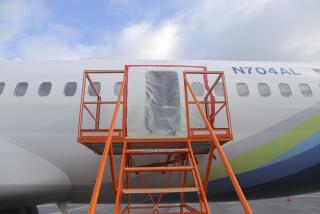Timely Checks on Jet Safety
- Share via
Few mechanical craft are inspected as often or as rigorously as civilian airliners. That’s particularly true in the case of a workhorse aircraft like the Boeing 737, which may land and take off again every hour. By contrast, a Boeing 747 jumbo jet will turn around just once every eight to 14 hours. You can see why a 737 needs inspection, based on flight hours, much more often than other jets.
But regular inspection has rarely applied to the internal wiring on 737s and some other jets. The wiring was thought to be good for the life of the aircraft. That changed when the cause of the crash of TWA Flight 800 in 1996 was laid to wiring inside the central fuel tank.
Since that disaster took 230 lives, things have worked the way they should in terms of aircraft safety. Prompt attention, no assumptions. It happened again last week when Continental Airlines found a 737 that was leaking fuel through two small holes. The holes may have been caused by sparks arcing between wires and a metal conduit that carried them through the aircraft’s fuel tank.
That supposition prompted an uncommonly quick response from the Federal Aviation Administration last Thursday, giving the airlines one week to inspect the wiring on their oldest 737s. By early Saturday, worn or chafed wiring had been found in half of the dozen or so jets inspected.
That prompted another prompt FAA response: Sunday’s grounding of all older 737s, which proved a smart idea. By Tuesday afternoon, some level of wear, from noticeable chafing to rare instances of exposed wires, was found on more than half of the cable wires inspected on 114 aircraft.
Fast action prevents accidents. It’s the way federal regulation and oversight ought to work.
More to Read
Sign up for The Wild
We’ll help you find the best places to hike, bike and run, as well as the perfect silent spots for meditation and yoga.
You may occasionally receive promotional content from the Los Angeles Times.






